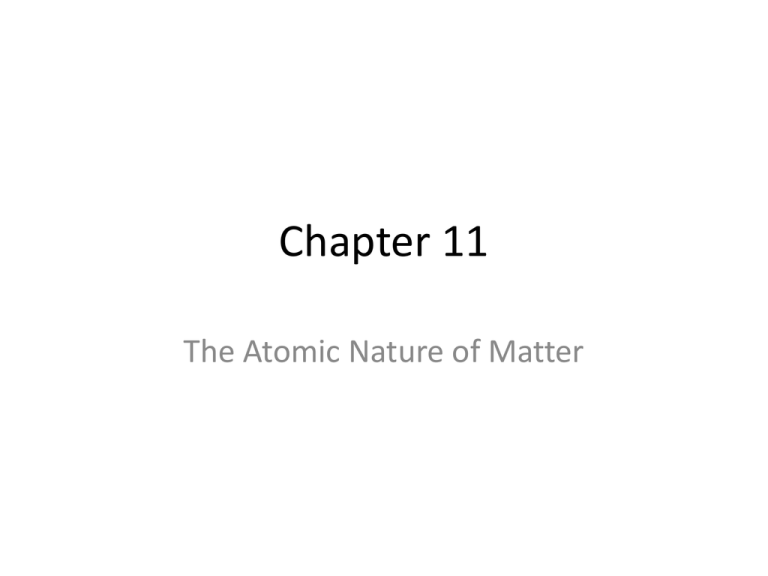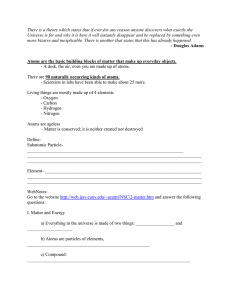Chapter 11 The Atomic Nature of Matter
advertisement

Chapter 11 The Atomic Nature of Matter Atomic Hypothesis • What is smallest divisible amount of matter has been pondered for thousands of years. • Aristotle disagreed with the idea of atoms and pushed the idea of matter beings composed of 4 elements. • During the early 1800’s atomic theory was reintroduced by John Dalton. Atomic Hypothesis • In 1827 Robert Brown hypothesized that these invisible atoms moved and collided, now called Brownian Motion. • 1905 Albert Einstein presented a detailed explanation of atomic nature that allowed atomic masses to be derived. The Elements • All things are made of a combination of 88 different elements. • There are a total (as of 2001) 118 different elements. • The most common element is Hydrogen, which stars use a fuel. • Elements that comprise all livings things are Hydrogen, Carbon, Oxygen, and Nitrogen. Elements • Atoms are incredibly small. • Atoms are numerous: there are about 1023 atoms in a gram of water. • Atoms are ageless: atoms are continually recycled into other materials. • Atoms get around: Since atoms are constantly in motion they have an endless ability for diffusion. Atomic Models • Since we cannot see atoms we have to make a model. • In 1911 Ernest Rutherford and Niels Bohr came up with the most common atomic model. Atomic Imagery • Atoms are too small to ever been seen with visible light. • Using high frequency electron beams pictures of element chains were photographed in the 1970. • Using a scanning tunneling microscope can revel the surface topology of atoms. Electrons • Electron is the Greek word for amber. • Using a cathode-ray tube the electron was discovered. • An electron has a negative charge and very little mass. Atomic Nucleus • Using an emitting alpha particles at a piece of thin gold foil caused some of the beam to scatter, while most of it passed through the material. • Scattered particles struck the nucleus of the gold atoms. • Electrons orbit the nucleus at a huge diameter. The Nucleus • Though small, subatomic particles have strong electrical fields. • These fields keep no bonded atoms from interacting. Proton • The nucleus’s active particle is the Proton. • Protons are 2000 times more massive then electrons. • Electrons stack into shells around the nucleus of an atom. • When an atom has a complete shell it becomes nearly chemically inert Neutrons • Neutrons are electrical inert and mass to the nucleus of the atoms. • Most atoms have a set number of neutrons, but this is not a set rule. • Isotopes are atoms that have an more or less neutrons. Quarks • Quarks are fundamental particles that build electrons, protons, and neutrons. • Quarks exists only in large particles and not individually. Elements, Compounds, Mixtures • Fundamental atomic compositions are elements. • Combinations of elements are called compounds. The atoms share electron bonds. • Substance that mix, but do not bond are called mixtures. Referances • http://www.colorado.edu/physics/2000/apple ts/







